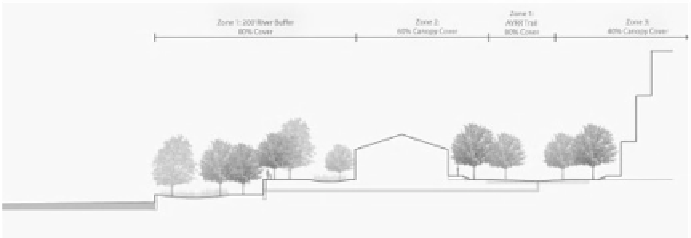Environmental Engineering Reference
In-Depth Information
Much of the community's sewer system, roadway and streets, pedestrian side-
walks, and other infrastructure elements are planned for reconstruction and offer
exciting opportunities for immediate greening of the urban fabric. The residential
community in East Liberty provides such an opportunity, with small “backyard
BMPs,” identified as attainable solutions to the greening goal. A combination
of
green infrastructure
measures will reduce the total impact of runoff to the
combined sewers to a level that will reduce the frequency of overflows during
extreme rainfall events, which combined with efforts to reduce surface pollutant
inputs should help in the restoration of water quality in the receiving rivers.
Allegheny Riverfront Vision Plan (2010)
The city of Pittsburgh, Pennsylvania, has undergone a major transformation
during the past four decades, as river-based industrial production facilities for
steel, aluminum, iron, glass, and related water-transported finished materials have
moved from the region and left behind a waterfront that contains some residen-
tial and commercial activity, but by and large is in need of redevelopment. As
the Urban Redevelopment Authority of Pittsburgh has considered this issue, they
retained a consulting team led by Perkins Eastman, Architects and Planners, and
including CH2M HILL and Veridian Associates, Landscape Architects. This team
was charged with formulating a “Vision Plan” that included the best elements of
land redevelopment, such as LID, and would lead the city to a livable, economi-
cally viable, and environmentally sustainable future, creating a vision that would
ultimately extend throughout the city from the waterfront of the Allegheny River
(Figure B-20).
The plan envisioned both the restoration of existing residential communities
and “greening” of commercial and community parcels, as well as setting specific
goals for both stormwater management and landscape design. The city is bur-
dened with combined sewers, and during heavy rainfall some 52 CSOs discharge
to the river along this waterfront, severely polluting the river and preventing a
comprehensive redevelopment program. The restoration of hydrology includes
the planting of trees throughout the 1,600-acre study, ultimately achieving a
Figure B-20
The Allegheny Riverfront Vision integrates vegetation with structures.












Search WWH ::

Custom Search